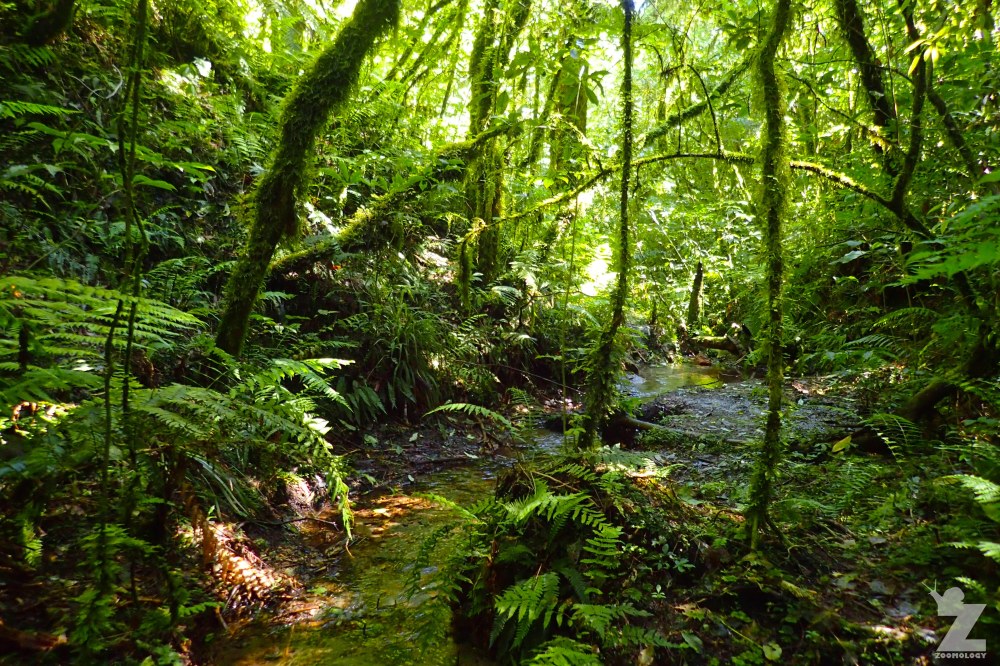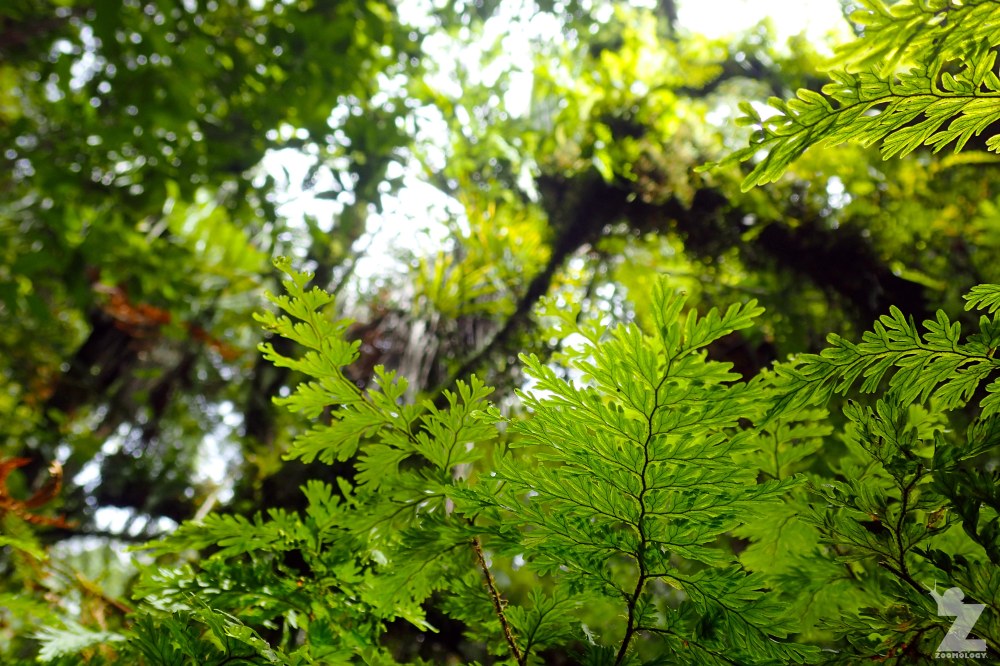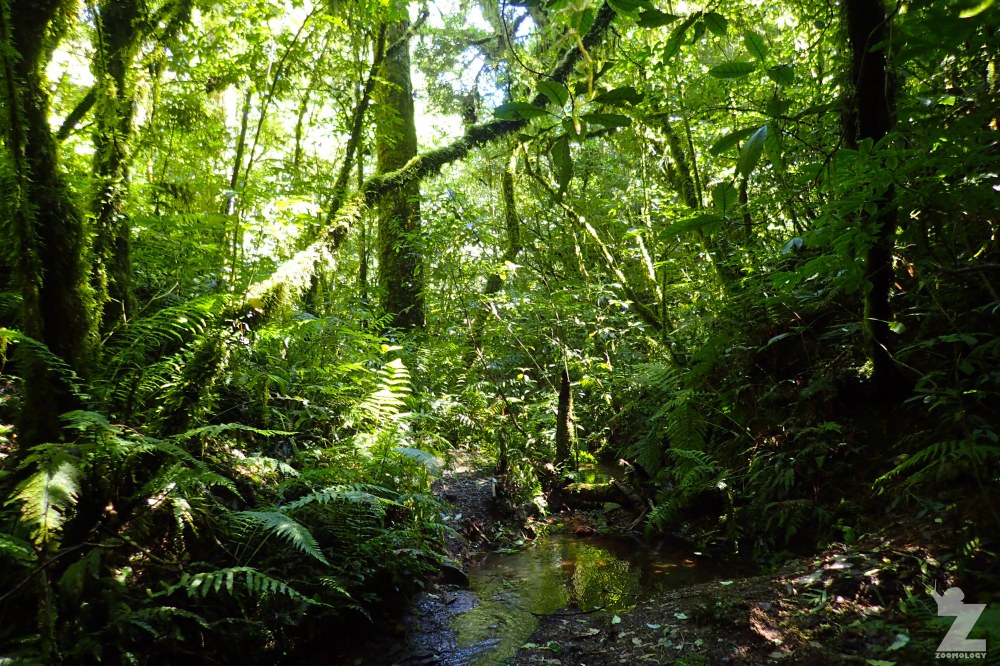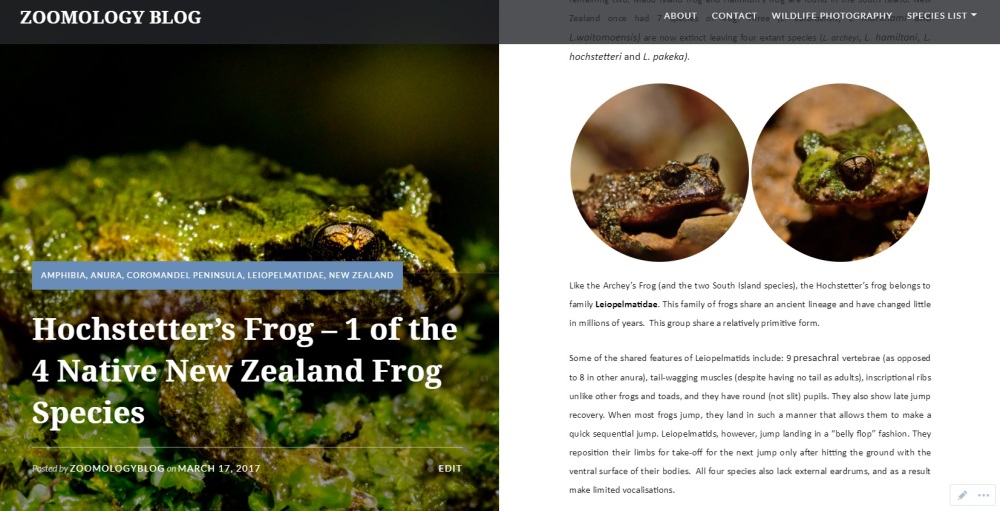
Click to zoom in
Three Archey’s frogs, five Hochstetter’s frogs, three Coromandel striped geckos, and one forest gecko… all seen in less than a 24 hour period! Whenever we visit Sara and Ro out at Mahakirau Forest Estate, we are always spoilt with wildlife encounters.
Mahakirau Forest Estate
The Mahakirau Forest Estate is located on the Coromandel Peninsula, New Zealand, and is made up of almost 600 hectares of native forest. This is divided into 24 private properties which are covenanted with the QEII National Trust (560ha) or with Thames Coromandel District Council (16ha). Introduced animal and plant controls are in place on the estate to protect and restore biodiversity. Their efforts do not go unnoticed with many very rare species being found in the area!

Click to zoom in
Here is a brief overview of some of the species you might encounter there:
Reptiles and Amphibians
- Coromandel striped gecko (Toropuku “Coromandel”)
- Forest gecko (Mokopirirakau granulatus)
- Pacific gecko (Dactylocnemis pacificus)
- Hochstetter’s frog (Leiopelma hochstetteri)
- Archey’s frog (Leiopelma archeyi)
Birds
- North Island kākā (Nestor meridionalis septentrionalis)
- North Island brown kiwi (Apteryx mantelli)
- Kererū (Hemiphaga novaeseelandiae)
- Tui (Prosthemadera novaeseelandiae)
- Bellbird (Anthornis melanura)
- Fantail (Rhipidura fuliginosa)
- Tomtit (Petroica macrocephala toitoi)
- Silvereye (Zosterops lateralis)
- Grey warbler (Gerygone igata)
- Kingfisher (Todiramphus sanctus vagans)
- Morepork (Ninox novaeseelandiae)
- Shining cuckoo (Chrysococcyx lucidas)
- Long-tailed cuckoo (Urodynamis taitensis)
Insects & other Invertebrates
- Helm’s butterfly (Dodonidia helmsii)
- Red Admiral (Vanessa gonerilla)
- Yellow Admiral (Vanessa itea)
- Checkered cave wētā (Gymnoplectron uncata)
- Painted cave wētā (Neonetus spp.)
- Velvet worms (Peripatoides indigo & P. novaezealandiae)
Freshwater Fish
- Longfin eel (Anguilla dieffenbachii)
- Kokopu spp.
Flora
- Northern rātā (Metrosideros robusta)
- Kauri (Agathis australis)
- Ramarama (Lophomyrtus bullata)
- Miro (Podocarpus ferrugineus)
- Rimu (Dacrydium cupressinum)
- Mountain tōtara (Podocarpus hallii)
- Kahikatea (Dacrycarpus dacrydioides)
- Kaikawaka (Libocedrus bidwillii)
- Tanekaha (Phyllocladus trichomanoides)
- Taraire (Beilschmiedia tarairi)
- Pukatea (Laurelia novae-zelandiae)
- Kohekohe (Dysoxylum spectabile)
- Kānuka (Kunzea spp.)
- Mānuka (Leptospermum scoparium)
- King Fern
- Kirk’s daisy (Brachyglottis kirkii)

Click to zoom in
OUR ENCOUNTERS
The following photos are a few highlights of our Mahakirau Forest Estate explorations. We went out on a night-walk where we spotted the Archey’s frog, forest gecko and Coromandel striped gecko. We also found Hochstetter’s frogs the next morning on a wander along one of the forested streams.

Click to zoom in
Archey’s Frog (Leiopelma archeyi)
Family: Leiopelmatidae
New Zealand Status: Endemic
Conservation Status: Threatened – Nationally Vulnerable (NZTCS), Critically Endangered (IUCN)
The Archey’s frog is the only terrestrial frog found on mainland New Zealand. It is also our smallest native frog, growing up to 37 mm long.
Click to zoom in
Check out our blog post about the Archey’s frog from a previous trip here:
Hochstetter’s Frog (Leiopelma hochstetteri)
Family: Leiopelmatidae
New Zealand Status: Endemic
Conservation Status: At Risk – Declining (NZTCS)
The Hochstetter’s frog is New Zealand’s most widespread native frog. It has partially webbed feet and has more warts than our other native frogs.
Click to zoom in
Check out our blog post about the Hochstetter’s frog from a previous trip here:
Coromandel Striped Gecko (Toropuku “Coromandel”)
Family: Diplodactylidae
New Zealand Status: Endemic
Conservation Status: Threatened – Nationally Vulnerable (NZTCS)
The Coromandel striped gecko is considered to be one of the rarest and most restricted of the New Zealand geckos.
Click to zoom in
Check out our blog post about the Coromandel striped gecko from a previous trip here:
Forest Gecko (Mokopirirakau granulatus)
Family: Diplodactylidae
New Zealand Status: Endemic
Conservation Status: At Risk – Declining (NZTCS)
The Māori name for the forest gecko is moko pirirākau, meaning “the lizard that clings to trees.” You might have noticed that this is also its genus.
Until Next Time
Thank you, Sara and Ro, for having us to stay once again. We always enjoy our time with you and the other Mahakirau residents (of all varieties, humans included😊).
What a special place you call “home”!

Click to zoom in
References and Further Reading
Department of Conservation Website – Archey’s Frog – http://www.doc.govt.nz/nature/native-animals/reptiles-and-frogs/frogs-pepeketua/archeys-frog/
(Retrieved 28 March, 2018)
Department of Conservation Website – Frogs/Pepeketua – http://www.doc.govt.nz/nature/native-animals/reptiles-and-frogs/frogs-pepeketua/
(Retrieved 28 March, 2018)
Department of Conservation Website – New Zealand Threat Classification System (NZTCS) – http://www.doc.govt.nz/about-us/science-publications/conservation-publications/nz-threat-classification-system/
(Retrieved 13 March, 2018)
IUCN Red List of Threatened Species Website – http://www.iucnredlist.org/
(Retrieved 13 March, 2018)
Mahakirau Forest Estate Website – http://www.mahakirau.co.nz/
(Retrieved 13 March, 2018)
Mahakirau Forest Estate Facebook Page – https://www.facebook.com/Mahakirau/
(Retrieved 28 March, 2018)
QEII National Trust Website – https://qeiinationaltrust.org.nz/
(Retrieved 13 March, 2018)
![Leiopelma archeyi [ARCHEY'S FROG] Mahakirau Forest Estate, New Zealand 16-02-2018 Zoomology (1) Leiopelma archeyi [ARCHEY'S FROG] Mahakirau Forest Estate, New Zealand 16-02-2018 Zoomology (1)](https://zoomologyblog.files.wordpress.com/2018/04/leiopelma-archeyi-archeys-frog-mahakirau-forest-estate-new-zealand-16-02-2018-zoomology-1.jpg?w=663&resize=663%2C442&h=442#038;h=442)
![Leiopelma archeyi [ARCHEY'S FROG] Mahakirau Forest Estate, New Zealand 16-02-2018 Zoomology (3) Leiopelma archeyi [ARCHEY'S FROG] Mahakirau Forest Estate, New Zealand 16-02-2018 Zoomology (3)](https://zoomologyblog.files.wordpress.com/2018/04/leiopelma-archeyi-archeys-frog-mahakirau-forest-estate-new-zealand-16-02-2018-zoomology-3.jpg?w=329&resize=329%2C219&h=219#038;h=219)
![Leiopelma archeyi [ARCHEY'S FROG] Mahakirau Forest Estate, New Zealand 16-02-2018 Zoomology (4) Leiopelma archeyi [ARCHEY'S FROG] Mahakirau Forest Estate, New Zealand 16-02-2018 Zoomology (4)](https://zoomologyblog.files.wordpress.com/2018/04/leiopelma-archeyi-archeys-frog-mahakirau-forest-estate-new-zealand-16-02-2018-zoomology-4.jpg?w=329&resize=329%2C219&h=219#038;h=219)
![Leiopelma archeyi [ARCHEY'S FROG] Mahakirau Forest Estate, New Zealand 16-02-2018 Zoomology (5) Leiopelma archeyi [ARCHEY'S FROG] Mahakirau Forest Estate, New Zealand 16-02-2018 Zoomology (5)](https://zoomologyblog.files.wordpress.com/2018/04/leiopelma-archeyi-archeys-frog-mahakirau-forest-estate-new-zealand-16-02-2018-zoomology-5.jpg?w=330&resize=330%2C220&h=220#038;h=220)
![Leiopelma archeyi [ARCHEY'S FROG] Mahakirau Forest Estate, New Zealand 16-02-2018 Zoomology (6) Leiopelma archeyi [ARCHEY'S FROG] Mahakirau Forest Estate, New Zealand 16-02-2018 Zoomology (6)](https://zoomologyblog.files.wordpress.com/2018/04/leiopelma-archeyi-archeys-frog-mahakirau-forest-estate-new-zealand-16-02-2018-zoomology-6.jpg?w=329&resize=329%2C220&h=220#038;h=220)
![Leiopelma archeyi [ARCHEY'S FROG] Mahakirau Forest Estate, New Zealand 16-02-2018 Zoomology (8) Leiopelma archeyi [ARCHEY'S FROG] Mahakirau Forest Estate, New Zealand 16-02-2018 Zoomology (8)](https://zoomologyblog.files.wordpress.com/2018/04/leiopelma-archeyi-archeys-frog-mahakirau-forest-estate-new-zealand-16-02-2018-zoomology-8.jpg?w=329&resize=329%2C220&h=220#038;h=220)
![Leiopelma archeyi [ARCHEY'S FROG] Mahakirau Forest Estate, New Zealand 16-02-2018 Zoomology (10) Leiopelma archeyi [ARCHEY'S FROG] Mahakirau Forest Estate, New Zealand 16-02-2018 Zoomology (10)](https://zoomologyblog.files.wordpress.com/2018/04/leiopelma-archeyi-archeys-frog-mahakirau-forest-estate-new-zealand-16-02-2018-zoomology-10.jpg?w=329&resize=329%2C219&h=219#038;h=219)
![Leiopelma archeyi [ARCHEY'S FROG] Mahakirau Forest Estate, New Zealand 16-02-2018 Zoomology (12) Leiopelma archeyi [ARCHEY'S FROG] Mahakirau Forest Estate, New Zealand 16-02-2018 Zoomology (12)](https://zoomologyblog.files.wordpress.com/2018/04/leiopelma-archeyi-archeys-frog-mahakirau-forest-estate-new-zealand-16-02-2018-zoomology-12.jpg?w=329&resize=329%2C219&h=219#038;h=219)
![Leiopelma archeyi [ARCHEY'S FROG] Mahakirau Forest Estate, New Zealand 16-02-2018 Zoomology (13) Leiopelma archeyi [ARCHEY'S FROG] Mahakirau Forest Estate, New Zealand 16-02-2018 Zoomology (13)](https://zoomologyblog.files.wordpress.com/2018/04/leiopelma-archeyi-archeys-frog-mahakirau-forest-estate-new-zealand-16-02-2018-zoomology-13.jpg?w=663&resize=663%2C442&h=442#038;h=442)
![Leiopelma archeyi [ARCHEY'S FROG] Mahakirau Forest Estate, New Zealand 16-02-2018 Zoomology (14) Leiopelma archeyi [ARCHEY'S FROG] Mahakirau Forest Estate, New Zealand 16-02-2018 Zoomology (14)](https://zoomologyblog.files.wordpress.com/2018/04/leiopelma-archeyi-archeys-frog-mahakirau-forest-estate-new-zealand-16-02-2018-zoomology-14.jpg?w=496&resize=496%2C331&h=331#038;h=331)
![Leiopelma archeyi [ARCHEY'S FROG] Mahakirau Forest Estate, New Zealand 16-02-2018 Zoomology (16) Leiopelma archeyi [ARCHEY'S FROG] Mahakirau Forest Estate, New Zealand 16-02-2018 Zoomology (16)](https://zoomologyblog.files.wordpress.com/2018/04/leiopelma-archeyi-archeys-frog-mahakirau-forest-estate-new-zealand-16-02-2018-zoomology-16.jpg?w=496&resize=496%2C331&h=331#038;h=331)
![Leiopelma archeyi [ARCHEY'S FROG] Mahakirau Forest Estate, New Zealand 16-02-2018 Zoomology (17) Leiopelma archeyi [ARCHEY'S FROG] Mahakirau Forest Estate, New Zealand 16-02-2018 Zoomology (17)](https://zoomologyblog.files.wordpress.com/2018/04/leiopelma-archeyi-archeys-frog-mahakirau-forest-estate-new-zealand-16-02-2018-zoomology-17.jpg?w=663&resize=663%2C442&h=442#038;h=442)
![Leiopelma archeyi [ARCHEY'S FROG] Mahakirau Forest Estate, New Zealand 16-02-2018 Zoomology (18) Leiopelma archeyi [ARCHEY'S FROG] Mahakirau Forest Estate, New Zealand 16-02-2018 Zoomology (18)](https://zoomologyblog.files.wordpress.com/2018/04/leiopelma-archeyi-archeys-frog-mahakirau-forest-estate-new-zealand-16-02-2018-zoomology-18.jpg?w=329&resize=329%2C219&h=219#038;h=219)
![Leiopelma archeyi [ARCHEY'S FROG] Mahakirau Forest Estate, New Zealand 16-02-2018 Zoomology Leiopelma archeyi [ARCHEY'S FROG] Mahakirau Forest Estate, New Zealand 16-02-2018 Zoomology](https://zoomologyblog.files.wordpress.com/2018/04/leiopelma-archeyi-archeys-frog-mahakirau-forest-estate-new-zealand-16-02-2018-zoomology.jpg?w=329&resize=329%2C219&h=219#038;h=219)

![Leiopelma hochstetteri [HOCHSTETTER'S FROG] Mahakirau Forest Estate, New Zealand 17-02-18 Zoomology (1) Leiopelma hochstetteri [HOCHSTETTER'S FROG] Mahakirau Forest Estate, New Zealand 17-02-18 Zoomology (1)](https://zoomologyblog.files.wordpress.com/2018/04/leiopelma-hochstetteri-hochstetters-frog-mahakirau-forest-estate-new-zealand-17-02-18-zoomology-1.jpg?w=663&resize=663%2C442&h=442#038;h=442)
![Leiopelma hochstetteri [HOCHSTETTER'S FROG] Mahakirau Forest Estate, New Zealand 17-02-18 Zoomology (4) Leiopelma hochstetteri [HOCHSTETTER'S FROG] Mahakirau Forest Estate, New Zealand 17-02-18 Zoomology (4)](https://zoomologyblog.files.wordpress.com/2018/04/leiopelma-hochstetteri-hochstetters-frog-mahakirau-forest-estate-new-zealand-17-02-18-zoomology-4.jpg?w=329&resize=329%2C219&h=219#038;h=219)
![Leiopelma hochstetteri [HOCHSTETTER'S FROG] Mahakirau Forest Estate, New Zealand 17-02-18 Zoomology (5) Leiopelma hochstetteri [HOCHSTETTER'S FROG] Mahakirau Forest Estate, New Zealand 17-02-18 Zoomology (5)](https://zoomologyblog.files.wordpress.com/2018/04/leiopelma-hochstetteri-hochstetters-frog-mahakirau-forest-estate-new-zealand-17-02-18-zoomology-5.jpg?w=329&resize=329%2C219&h=219#038;h=219)
![Leiopelma hochstetteri [HOCHSTETTER'S FROG] Mahakirau Forest Estate, New Zealand 17-02-18 Zoomology (6) Leiopelma hochstetteri [HOCHSTETTER'S FROG] Mahakirau Forest Estate, New Zealand 17-02-18 Zoomology (6)](https://zoomologyblog.files.wordpress.com/2018/04/leiopelma-hochstetteri-hochstetters-frog-mahakirau-forest-estate-new-zealand-17-02-18-zoomology-6.jpg?w=246&resize=246%2C164&h=164#038;h=164)
![Leiopelma hochstetteri [HOCHSTETTER'S FROG] Mahakirau Forest Estate, New Zealand 17-02-18 Zoomology (7) Leiopelma hochstetteri [HOCHSTETTER'S FROG] Mahakirau Forest Estate, New Zealand 17-02-18 Zoomology (7)](https://zoomologyblog.files.wordpress.com/2018/04/leiopelma-hochstetteri-hochstetters-frog-mahakirau-forest-estate-new-zealand-17-02-18-zoomology-7.jpg?w=246&resize=246%2C164&h=164#038;h=164)
![Leiopelma hochstetteri [HOCHSTETTER'S FROG] Mahakirau Forest Estate, New Zealand 17-02-18 Zoomology (12) Leiopelma hochstetteri [HOCHSTETTER'S FROG] Mahakirau Forest Estate, New Zealand 17-02-18 Zoomology (12)](https://zoomologyblog.files.wordpress.com/2018/04/leiopelma-hochstetteri-hochstetters-frog-mahakirau-forest-estate-new-zealand-17-02-18-zoomology-12.jpg?w=246&resize=246%2C164&h=164#038;h=164)
![Leiopelma hochstetteri [HOCHSTETTER'S FROG] Mahakirau Forest Estate, New Zealand 17-02-18 Zoomology (13) Leiopelma hochstetteri [HOCHSTETTER'S FROG] Mahakirau Forest Estate, New Zealand 17-02-18 Zoomology (13)](https://zoomologyblog.files.wordpress.com/2018/04/leiopelma-hochstetteri-hochstetters-frog-mahakirau-forest-estate-new-zealand-17-02-18-zoomology-13.jpg?w=246&resize=246%2C164&h=164#038;h=164)

![Toropuku “Coromandel” [COROMANDEL STRIPED GECKO] Mahakirau Forest Estate, New Zealand 16-02-18 Zoomology (45) Toropuku “Coromandel” [COROMANDEL STRIPED GECKO] Mahakirau Forest Estate, New Zealand 16-02-18 Zoomology (45)](https://zoomologyblog.files.wordpress.com/2018/04/toropuku-e2809ccoromandele2809d-coromandel-striped-gecko-mahakirau-forest-estate-new-zealand-16-02-18-zoomology-45.jpg?w=663&resize=663%2C442&h=442#038;h=442)
![Toropuku “Coromandel” [COROMANDEL STRIPED GECKO] Mahakirau Forest Estate, New Zealand 16-02-18 Zoomology (46) Toropuku “Coromandel” [COROMANDEL STRIPED GECKO] Mahakirau Forest Estate, New Zealand 16-02-18 Zoomology (46)](https://zoomologyblog.files.wordpress.com/2018/04/toropuku-e2809ccoromandele2809d-coromandel-striped-gecko-mahakirau-forest-estate-new-zealand-16-02-18-zoomology-46.jpg?w=329&resize=329%2C219&h=219#038;h=219)
![Toropuku “Coromandel” [COROMANDEL STRIPED GECKO] Mahakirau Forest Estate, New Zealand 16-02-18 Zoomology (47) Toropuku “Coromandel” [COROMANDEL STRIPED GECKO] Mahakirau Forest Estate, New Zealand 16-02-18 Zoomology (47)](https://zoomologyblog.files.wordpress.com/2018/04/toropuku-e2809ccoromandele2809d-coromandel-striped-gecko-mahakirau-forest-estate-new-zealand-16-02-18-zoomology-47.jpg?w=329&resize=329%2C219&h=219#038;h=219)
![Toropuku “Coromandel” [COROMANDEL STRIPED GECKO] Mahakirau Forest Estate, New Zealand 16-02-18 Zoomology (49) Toropuku “Coromandel” [COROMANDEL STRIPED GECKO] Mahakirau Forest Estate, New Zealand 16-02-18 Zoomology (49)](https://zoomologyblog.files.wordpress.com/2018/04/toropuku-e2809ccoromandele2809d-coromandel-striped-gecko-mahakirau-forest-estate-new-zealand-16-02-18-zoomology-49.jpg?w=329&resize=329%2C219&h=219#038;h=219)
![Toropuku “Coromandel” [COROMANDEL STRIPED GECKO] Mahakirau Forest Estate, New Zealand 16-02-18 Zoomology (50) Toropuku “Coromandel” [COROMANDEL STRIPED GECKO] Mahakirau Forest Estate, New Zealand 16-02-18 Zoomology (50)](https://zoomologyblog.files.wordpress.com/2018/04/toropuku-e2809ccoromandele2809d-coromandel-striped-gecko-mahakirau-forest-estate-new-zealand-16-02-18-zoomology-50.jpg?w=329&resize=329%2C219&h=219#038;h=219)
![Toropuku “Coromandel” [COROMANDEL STRIPED GECKO] Mahakirau Forest Estate, New Zealand 16-02-18 Zoomology (51) Toropuku “Coromandel” [COROMANDEL STRIPED GECKO] Mahakirau Forest Estate, New Zealand 16-02-18 Zoomology (51)](https://zoomologyblog.files.wordpress.com/2018/04/toropuku-e2809ccoromandele2809d-coromandel-striped-gecko-mahakirau-forest-estate-new-zealand-16-02-18-zoomology-51.jpg?w=663&resize=663%2C442&h=442#038;h=442)
![Toropuku “Coromandel” [COROMANDEL STRIPED GECKO] Mahakirau Forest Estate, New Zealand 16-02-18 Zoomology (52) Toropuku “Coromandel” [COROMANDEL STRIPED GECKO] Mahakirau Forest Estate, New Zealand 16-02-18 Zoomology (52)](https://zoomologyblog.files.wordpress.com/2018/04/toropuku-e2809ccoromandele2809d-coromandel-striped-gecko-mahakirau-forest-estate-new-zealand-16-02-18-zoomology-52.jpg?w=496&resize=496%2C331&h=331#038;h=331)
![Toropuku “Coromandel” [COROMANDEL STRIPED GECKO] Mahakirau Forest Estate, New Zealand 16-02-18 Zoomology (53) Toropuku “Coromandel” [COROMANDEL STRIPED GECKO] Mahakirau Forest Estate, New Zealand 16-02-18 Zoomology (53)](https://zoomologyblog.files.wordpress.com/2018/04/toropuku-e2809ccoromandele2809d-coromandel-striped-gecko-mahakirau-forest-estate-new-zealand-16-02-18-zoomology-53.jpg?w=496&resize=496%2C331&h=331#038;h=331)
![Toropuku “Coromandel” [COROMANDEL STRIPED GECKO] Mahakirau Forest Estate, New Zealand 16-02-18 Zoomology (54) Toropuku “Coromandel” [COROMANDEL STRIPED GECKO] Mahakirau Forest Estate, New Zealand 16-02-18 Zoomology (54)](https://zoomologyblog.files.wordpress.com/2018/04/toropuku-e2809ccoromandele2809d-coromandel-striped-gecko-mahakirau-forest-estate-new-zealand-16-02-18-zoomology-54.jpg?w=246&resize=246%2C164&h=164#038;h=164)
![Toropuku “Coromandel” [COROMANDEL STRIPED GECKO] Mahakirau Forest Estate, New Zealand 16-02-18 Zoomology (55) Toropuku “Coromandel” [COROMANDEL STRIPED GECKO] Mahakirau Forest Estate, New Zealand 16-02-18 Zoomology (55)](https://zoomologyblog.files.wordpress.com/2018/04/toropuku-e2809ccoromandele2809d-coromandel-striped-gecko-mahakirau-forest-estate-new-zealand-16-02-18-zoomology-55.jpg?w=246&resize=246%2C164&h=164#038;h=164)
![Toropuku “Coromandel” [COROMANDEL STRIPED GECKO] Mahakirau Forest Estate, New Zealand 16-02-18 Zoomology (56) Toropuku “Coromandel” [COROMANDEL STRIPED GECKO] Mahakirau Forest Estate, New Zealand 16-02-18 Zoomology (56)](https://zoomologyblog.files.wordpress.com/2018/04/toropuku-e2809ccoromandele2809d-coromandel-striped-gecko-mahakirau-forest-estate-new-zealand-16-02-18-zoomology-56.jpg?w=246&resize=246%2C164&h=164#038;h=164)
![Toropuku “Coromandel” [COROMANDEL STRIPED GECKO] Mahakirau Forest Estate, New Zealand 16-02-18 Zoomology (57) Toropuku “Coromandel” [COROMANDEL STRIPED GECKO] Mahakirau Forest Estate, New Zealand 16-02-18 Zoomology (57)](https://zoomologyblog.files.wordpress.com/2018/04/toropuku-e2809ccoromandele2809d-coromandel-striped-gecko-mahakirau-forest-estate-new-zealand-16-02-18-zoomology-57.jpg?w=246&resize=246%2C164&h=164#038;h=164)

![Hoplodactylus granulatus [FOREST GECKO] Mahakirau Forest Estate, New Zealand 16-02-18 Zoomology (30)](https://zoomologyblog.files.wordpress.com/2018/04/hoplodactylus-granulatus-forest-gecko-mahakirau-forest-estate-new-zealand-16-02-18-zoomology-30.jpg?w=1000)
Wonderful! We adore you and your work Emma & Tom. You belong to this special place too – come home soon! Xx
LikeLiked by 1 person
Thank you so much, Sara! That means a lot to us. 💕 We can’t wait! 😊
-Emma
LikeLike
Fabulous blog, location and wildlife. Great images as always!
LikeLiked by 1 person
Thank you, Pete! We had wonderful subjects! 🙂
-Emma
LikeLiked by 1 person
The photographs are amazing, as is the post!
LikeLiked by 1 person
Hi Tamanna,
Thank you very much!
-Emma
LikeLiked by 1 person
Love that Archey’s Frog! So cute!!
LikeLiked by 1 person
I know, right?! #adorableamphibians🐸
-Emma
LikeLiked by 1 person
Beautiful creatures in a fantastic place.
LikeLiked by 1 person
Thank you! We always feel so lucky when we get to visit Mahakirau Forest Estate. 🙂
-Emma
LikeLiked by 1 person
What a fantastic place! I could walk for days in the forest! Thanks for showing the diversity. Your pictures are amazing!
LikeLiked by 1 person
Thank you very much! It really is an amazing place. We’re happy we could share it with you. 😀
-Emma
LikeLiked by 1 person
How exciting! I need to visit New Zealand sometime.
LikeLiked by 1 person
Definitely! If you ever do make the trip, let us know and maybe we can give you a few travel/wildlife ideas. 🌞
-Emma
LikeLiked by 1 person
Oh we are definitely going to do the trip. Rough plan is fly into Las Vegas, and head north in a loop to Zion, Bryce, Arches, Canyonlands, etc.
LikeLiked by 1 person
I have two trips on the brain at once. For New Zealand we are very interested in the wildlife – it looks amazing! When you mentioned bellbird in your post, I remembered being in awe by that one in Australia.
LikeLiked by 1 person
Both trips sound exciting, Pam! Ah, yes, we love the bellbird, too. They have such a musical voice!
-Emma
LikeLiked by 1 person